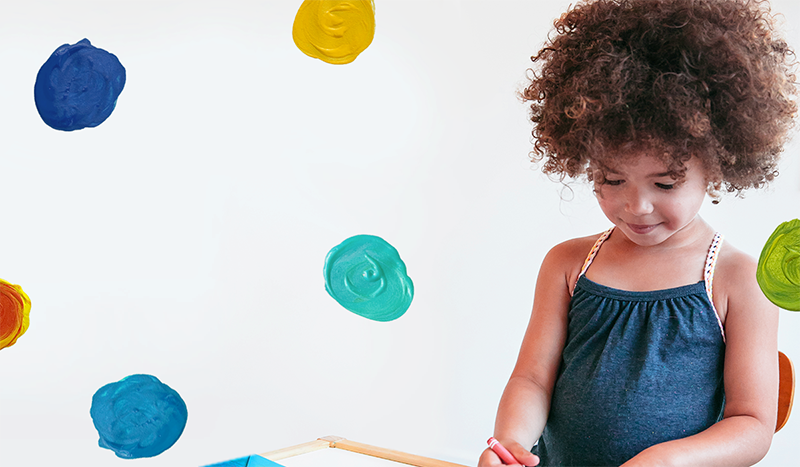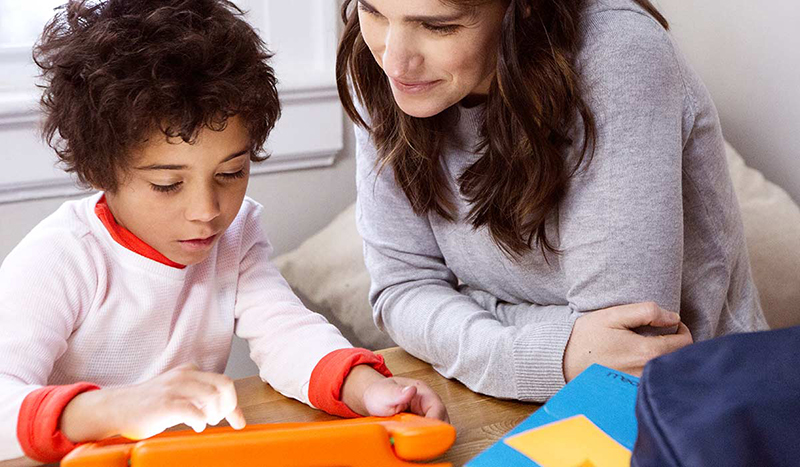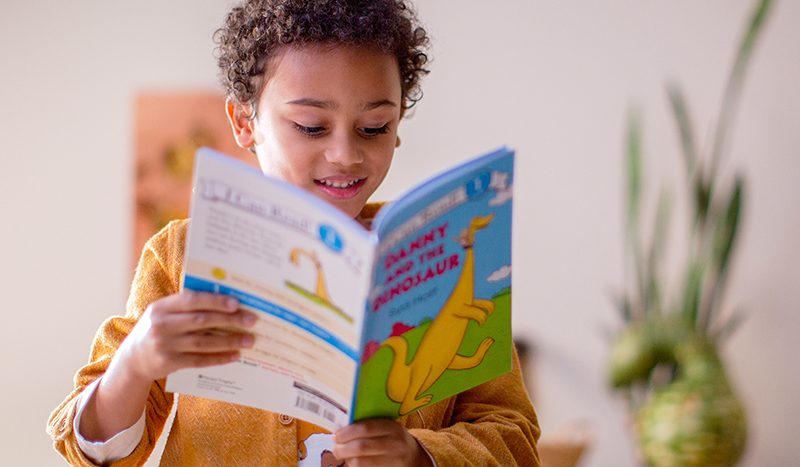Children learn to walk and talk naturally, but that’s not the case with reading. Reading strategies are designed to help your child develop a strong reading foundation — one built with confidence, engagement, and joy!
As a parent, you are most likely always looking for techniques that make your child want to learn. We’re here to help you and your child on their journey as a budding reader.
Try the 11 reading-strategy suggestions below for kids who are beginning to read all the way to those reading advanced chapter books! We’ve made it easy for you to see what skill each strategy focuses on so you can help your child in a way that’s right for their reading level.
But before we get to these ideas, let’s discuss what reading strategies are and how to effectively teach them to your young reader.
What Are Reading Strategies?

Reading strategies are activities that help your child understand what they’re reading, build vocabulary, and improve their reading skills.
Think of each reading strategy as a tool your child can pull out to help them read. For example, if they get stuck on a word, they can think of all the decoding strategies they’ve learned and pick one to try.
If that one doesn’t work and they’re still stuck, they can try another one. By experimenting with different strategies, your child learns to figure out the words in front of them and continues developing their reading skills.
Since each reading strategy won’t work in every situation, your child must have a variety of methods in their reading toolbox. As they gain experience, they’ll better know which one to use when.
Additionally, knowing the words in a book is not the only reading skill. Children need to develop comprehension skills as well as the ability to get “lost” in a book. Reading strategies that promote this engagement are very valuable.
Why Reading Strategies Are Important
When your child uses reading strategies, they are actively engaged in the reading process. This helps them understand the text better and makes reading more enjoyable.
Additionally, as we mentioned above, reading strategies help your child build their vocabulary, which is essential for reading comprehension. If they don’t understand what the words are, they can’t make sense of what they’re reading.
How To Help Your Child Become A Better Reader
Now that we’ve talked about the benefits of reading strategies, let’s take a look at how to teach them to your child.
First things first, teaching reading strategies at home doesn’t need to be complicated. You can use everyday activities to help your child practice their reading skills.
One of the best ways to teach reading strategies is to model them. This means showing your child how to use the strategy while sharing a story. For instance, if you’re showing how illustrations in a book can help you understand the text, point to the pictures as you read.
Say, “Pictures can give us more information about the story and what’s happening. I’ll look closely at this illustration to see if it helps me figure out what’s going on.” Then, ask your child to do the same and discuss the image together.
Think aloud as you read, telling your child what you’re doing and why it’s helpful. This gives your child insight into your thinking process and helps them learn to use the strategy independently.
You might say, “I don’t know this word, so I’ll try to break it into syllables and then put them together to help me remember what each part says.”
In addition to modeling, remind your child of other strategies they can use. For example, if you see that they’re struggling to sound out a longer word, encourage them to look for smaller words inside of it.
Helping your child strategize enables them to become more confident in their reading.
11 Fun And Helpful Reading Strategies
Use these reading strategies to help your child practice important literacy skills and become a more confident reader.
1) Reread Familiar Texts

You may feel pressured to always offer your child new and different stories. While that is great, it can also be just as helpful for your child to read the same book more than once.
Rereading helps your child in two major ways. It gives them confidence by letting them choose what to read, and it improves their fluency since they are more familiar with the words in the book, which means they can really indulge in and enjoy the story!
As the text becomes easier for your little one to read, they will feel a sense of accomplishment because they are reading with the ease of a fluent reader — this is a huge step for your child!
2) Ask Questions About The Story
Reading isn’t a passive activity. Instead, your child’s brain should actively engage with the text. Teaching them to ask questions is a great way to help them connect with the words on the page.
Asking questions can also help your child keep tabs on their comprehension. They can use questions to make sure they understand what the text says.
As you’re reading to your child, stop to ask questions throughout the story. For example, if the main character just did something, you can ask, “Why did she do that?” Give your child a chance to think about it and respond.
If you’re reading a non-fiction book together, you might encounter a new word. Point to it and ask, “What does that word mean?” If your child doesn’t know, it’s the perfect opportunity to look it up together.

3) Read Aloud
Reading aloud with your child is a great way to encourage them to read. Your child adores you — you’re probably their biggest inspiration! So when you have fun reading, they’ll want to join in.
Bedtime stories are an easy way to incorporate daily reading into your busy family routine. This time gives you and your child a chance to unwind and connect with one another.
While you read together, encourage your child to read as much of the text as they can. And before turning the page, ask them what they think will happen next. This helps them connect more deeply with the story by developing empathy for the characters or appreciating the humor.
Sometimes, though, your child might be shy about reading in front of you or answering questions. They know reading is important, and they want to succeed for you. The pressure that comes with that might make reading more difficult.
That’s OK! Give them plenty of praise and encouragement, and let them know they can take it as slow as they need to.
In the meantime, encourage them to host a special storytime with a stuffed animal or a favorite toy, any item that is guaranteed to make them smile and bring them comfort.
It may take some adjusting, but this strategy will get them confident and calm about reading.

4) Act It Out
You can make books literally come alive by acting them out. This is a dynamic and exciting way to encourage your child to love reading!
There’s no need to use elaborate props, a stage, or costumes (although, if time allows, your child might love to make a family theatre production!). Simply grab a couple of stuffed animals or toys that can play the part of the characters in the story you’re reading together.
This simple addition can increase the entertainment value for your child and give them a chance to express themselves through the story.
Encourage them to do funny voices and mimic the characters’ actions in the story. Plus, if you incorporate play into your reading, they’ll start to see the connection between the words on the page and the exciting adventure you are having with your imagination.
This is a great way for your child to bring the story to life!

5) Use A Reading Finger
Young readers’ eyes find it hard to follow a line of text from right to left. They may skip around or jump lines. It can also be hard for kids to stay focused on what they’re reading.
Using a finger to track words you are reading can be very helpful. Have them use their pointer finger to point to each word as they read it. Remind them to move their finger to the next word as they go.
It can also be helpful to have an index card or a folded sheet of paper that moves from line to line. Both of these methods can help your child keep their place while reading.
If your child doesn’t want to point to words as they read, you may find it beneficial to do the pointing yourself for a while until they feel more comfortable.
6) Take A Running Start
If your child gets stuck on a word while reading, ask them to take a running start. This means going back to the beginning of the sentence and trying to read the unknown word in context.
Sometimes, this is enough to help them decode the word and keep going. But, other times, the word will continue to trip them up. If this is the case, introduce a different strategy, such as covering up the suffix or prefix of a word and focusing on the root word first.
Running starts also improve reading comprehension overall as your child reviews the text.
7) Read Things That Are Not Books

If your child seems uninterested in reading books, divert their attention to other things. Magazines, movie titles, joke books, anything you come across!
For example, try asking your child to be your little helper. Anytime you need to look something up or read something, see if they can give it a go first (with your help if they need it, of course!).
This can be searching up movie times online or having them read a recipe to you out loud while you cook. They could read road signs, check the weather, or find restaurant or store hours. They can read emails from family and friends that live in other parts of the world.
For younger kids, try asking them to sound out simple words you come across throughout the day, such as the word “stop” on a stop sign.
Having your child help in this way is all about the little, daily things that fit into your life. And the effect of these small tasks will give your child a huge confidence boost!
8) Let Your Child Tell Their Own Story
Acting as your child’s reading partner doesn’t have to start and stop with traditional bedtime stories. Letting them tell their own story is a great way to stimulate their imagination and can help with reading, too!
Every now and then, consider swapping after-dinner storytime for storytelling night. Your child can tell you a story while you write it down. Try letting your little one come up with a different scene each day (or, if time allows, all at once).
If they’re old enough, they can also work on the story on their own, drawing pictures to go along with the text or designing a book cover. Once the story is finished, you can read it together!
This is a great way to encourage accomplishment in your child, too. They will have made something of their own creation and can see the imaginative, fun, and personal finished product.
Plus, learning how to tell a story will help immensely with your child’s reading comprehension. They will begin to inherently understand the ebbs and flows of a story as they create their own.
A cute bonus: You’ll have a keepsake to treasure for years to come!
9) Make A Prediction
Predicting is another vital reading strategy that can help your child figure out what will happen next in the story and make sense of the text overall, which builds comprehension.
When they come to a natural stopping point in their reading, ask them to pause for a moment. Then, ask your child what they think will happen next.
After they’ve made their predictions, encourage them to keep reading to see if they were right. If they weren’t, that’s OK! Remind them that authors have different ideas, so stories can sometimes turn out differently than we think they should.
For a more fundamental-level reading strategy, try letting your child predict the next word rather than what happens in the story next.
10) Retell The Story
After your child reads a book, ask them to retell the story to you. This reading strategy helps your child practice their comprehension skills.
As they tell you about the story, pay attention to the details they include. Does your child remember the main parts? Did they have a beginning, middle, and end in their retelling?
If not, practice the retelling strategy by using some fun activities. For example, ask your child to look back through the book and find pictures to help them tell the story.
You can also ask them to draw small pictures on different pieces of paper to represent the different phases — beginning, middle, and end.
Then, put these pictures into a stack and shuffle them up. Spread them out and ask your child to put them in order. Once they’re correctly in place, have them retell the story using the pictures.
When retelling, some kids have trouble with adding too many details. If your child wants to share all the things about the book they read, help them focus on the main events.
Modeling is a good way to reinforce this concept. Spend 10 or 15 minutes quietly reading. Then, when the time is up, take turns retelling what you read. Your child will see how you focus on the key points and quickly sum up the story when you share.
11) Make Pictures In Your Mind
As your child reads aloud, encourage them to visualize the story. This means using the words as clues and picturing the story in their mind.
At first, you might have to help them with this reading strategy. After reading a paragraph or two of a descriptive piece of text, stop and ask your child to describe the scene. If they aren’t sure, model the process for them.
Show them how to go back in the text and look for adjectives and other descriptive words. Then, discuss what type of mental image you have.
Take time to draw what you’re seeing in your mind and have your child do the same. Putting the mental image onto paper can help some kids better process what is going on in their brains.
Compare pictures, but first, remind your child that it’s OK to have different images because we look at things in our own unique way.
This strategy is beneficial when your child outgrows picture books because it helps them understand what they’re reading when they don’t see any illustrations to offer clues.
How Reading Strategies Build Different Skills

All of the different skills that go into reading can be a lot for kids (and parents!) to take in. Although learning to read may feel like a distant memory to us, kids are in the thick of grasping everything reading requires.
But what does reading require? And how do the strategies we mentioned help? Here are a few examples of the skills some of these strategies promote.
Rereading Helps With Decoding
We hinted at it above, but it’s important to get a clear understanding of decoding.
Decoding is the process of sounding out words. Children (and adults!) use this skill to break down words to specific sounds and then blend the sounds together to form the word correctly.
Decoding goes beyond understanding what sound each letter makes. Specifically, decoding involves becoming familiar with the relationship between letters and sounds (and their patterns).
The rereading strategy is helpful here because the more times your child sees a word the easier it will become for them to decode it and words like it. Removing the effort leaves a child free to really get lost in a story.
Our HOMER app is another tool your child can use to practice essential decoding skills.
Reading Things That Are Not Books Builds Fluency
Once your child can instantly recognize words on the page (even ones they don’t know), then they are considered fluent!
It’s important to note that there are different levels of reading fluency. For example, your child may be able to fluently read a first-grade book but not a ninth-grade book. The good news is that fluency grows the more your child reads!
Building fluency is a big end goal for children. We want your child to achieve this goal so they will know that reading can be fun and rewarding. The stronger reader they become, the more likely they are to love reading!
Remember that Rome wasn’t built in a day, and neither is a fluent reader. It may take your child some time and practice to build their confidence and fluency!
In terms of reading strategies, reading things that are not books is one that can help build fluency. So can taking a running start. After all, the more your child reads, the more fluent they will become.

Reading Aloud Helps With Vocabulary
Words, words, words! The more words your child is exposed to, the more they will learn. And children who have a good vocabulary are at an advantage when it comes to reading.
A growing vocabulary develops from conversation and from hearing books read aloud. Additionally, children who read a lot learn more new words than those who read less because they get introduced to vocabulary in context.
All of the reading strategies we mentioned can be helpful with expanding vocabulary, but we especially recommend reading aloud and varying the kinds of books you read with your child. This will increase their exposure to all kinds of words!
Letting Your Child Tell Their Own Story Encourages Executive Function
This may sound technical, but executive function is really just an umbrella term that deals with your child’s working memory, attentiveness, and their ability to think about different things one after another.
These things influence your child’s attitude and how they learn. That’s part of why we always encourage reading strategies and materials that create a fun, relaxed learning environment for your little one.
A good strategy for working on this skill would be letting your child tell their own story! You can also encourage them to use HOMER. They’ll practice important executive function skills as they play.

Make Reading Strategies Work For Your Family
Incorporating reading strategies doesn’t need to be difficult, and you can start to feel confident about your child’s improvements when you see the purpose behind these strategies.
No matter what reading strategy you choose — rereading, asking questions, reading aloud, acting it out, reading things that aren’t books, letting your child tell their own story, or any of the others — you can achieve at-home learning that fits into your life in a fun and easy way.
And if you’re looking for more resources, our kid-powered, personalized Learn & Grow App is the perfect place for your child to get in some safe, fun, and quality reading practice. Just 15 minutes a day is proven to increase reading scores by 74%!












